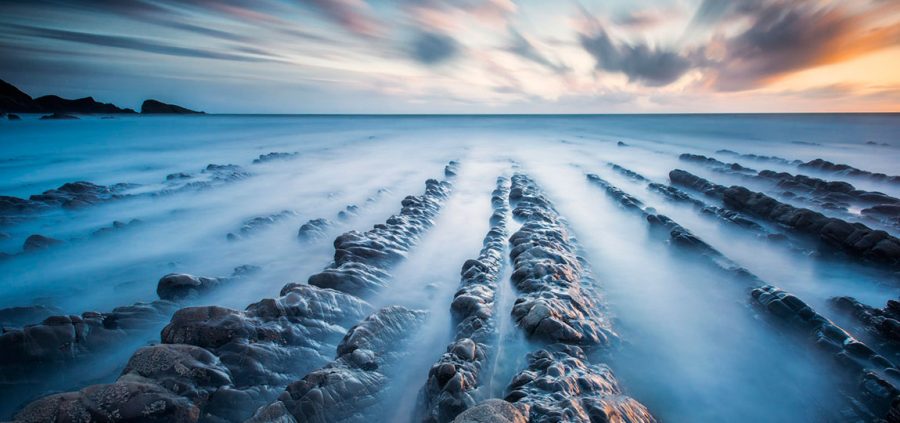Composition Tips: Leading Lines and Vanishing Points

Take a look at the most striking and lifelike landscape images, and you will almost certainly notice a common theme – they all have a strong, three-dimensional quality. The ability to convey an impression of depth is an important one for landscape photographers, but how exactly do you do this? Creative use of perspective is often the key to creating this visual illusion. Your choice of focal length, viewpoint and foreground will help you make a two-dimensional photograph, look three-dimensional. One of the best tricks for creating the impression of depth in landscape photography is to include a leading line, or vanishing point.

Leading Lines
Lines are powerful compositional tools that can help direct the viewer’s eye into – or through – the image-space. Our eyes are normally drawn to strong lines and they naturally wish to follow them – something we can consciously take advantage of when composing our shots. The landscape is full of strong shapes and lines, both manmade and forming naturally. Roads, footpaths, hedges, rope, chains, breakwaters, jetties and rivers are just an example of the type of lines found within the landscape. Some lines are less obvious, though, and they can be incomplete or even implied. For example, if you include a person or animal within your shot, we will instinctively follow their gaze into frame; while a trail of rocks or boulders can act like stepping stones, leading the eye into the photo. Once you begin to recognize this, you will begin to identify all types of potential lead-in lines within the world around you.



It is also important to appreciate that, to some degree, our choice of focal length and/or viewpoint can help create or exaggerate leading lines. Wide-angle lenses will distort perspective, stretching and exaggerating the size of nearby objects, lines and angles. It is important to recognize this fact if you wish to use leading lines as compositional aids. Don’t be afraid to go wide and get close to foreground objects in order to manipulate perspective creatively. However, you will require a large depth-of-field if you do this, so select a small aperture in the region of f/11 or f/16 and focus on the hyperfocal distance point.
Leading lines don’t have to be perfectly straight to effectively lead you into the image, or direct you to a certain focal point. These lines can be vertical, converging, diagonal, zigzagged, wavy, curved or S-shaped, yet their effect will be similar – encouraging the viewer’s eye into the frame and creating the impression of depth within your shots. They are a perfect tool for guiding the eye through the picture and can add dynamism and stability to your shots. Diagonal lines, in particular, are considered powerful within the laws of composition, while curved lines and arcs are more gentle and flow. Converging vertical lines are particularly photogenic, creating a vanishing point and an unrivalled sense of depth.

Vanishing Points
A vanishing point is formed when elements within the scene appear to diminish in size the further they are. The theory behind vanishing points is closely related to linear perspective and how the eye judges distance – lines and planes seem to narrow and converge as they get progressively further away. Anything with parallel lines works well. Paths, railway tracks, bridges, walls, a pier, shadows, canal or the plough lines in a field are an example of the type of things to look for within the landscape. If you place objects like this so that they are going away from the camera, leading into the distance, they will appear to converge – even though we understand that they do in fact remain parallel.

Horizontal lines will meet at a point on the horizon; vertical lines (when the camera is tilted upward) will converge at a point in the sky. Not only do lines help direct the eye into the image, they create a compelling sense of depth. Again, as photographers, we can exaggerate the effect by using a short focal length. Getting close to foreground subjects and using a wide-angle stretches the apparent distance between nearby and distant objects more than if you took the photo from further away using a longer length. Camera height also has an influence. The lower the shooting angle, the greater the level of convergence. However, a word of warning before you adopt a worm’s eye view for your vanishing point images. Low viewpoints can create issues with the amount of separation between key elements within your composition, so keep this in mind when composing low-level images.

Personally, I find a vertical format suits shooting a vanishing point best, further emphasizing the feeling of depth and height – so I will only turn my camera on its side when shooting images boasting strong converging lines. As lines converge as they recede into the distance, you are really able to simulate three-dimensions in a two-dimensional photo. However, one risk when including a vanishing point is that if it doesn’t lead to a point of interest on the horizon, the composition may not maintain the viewer’s interest. Therefore, ideally, it is useful to include a good focal point at, or close to, the vanishing point itself.

So, the moral of the story is to look closely at your surroundings for lines and shapes that you can include as a framing aid to lead your eye through your photos and convey depth and dynamism. Lines can prove to be a key visual tool – your compositions will often be stronger as a result of including them.





